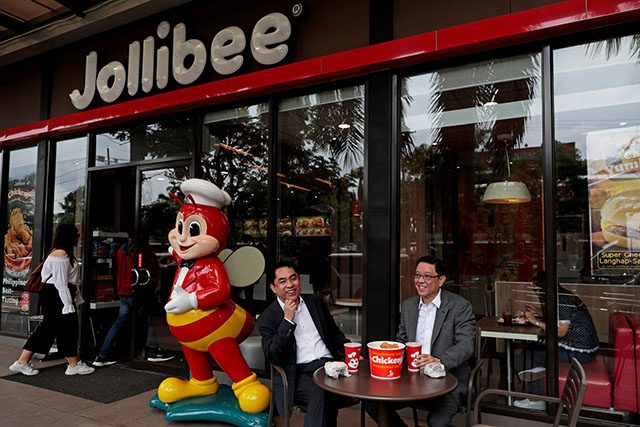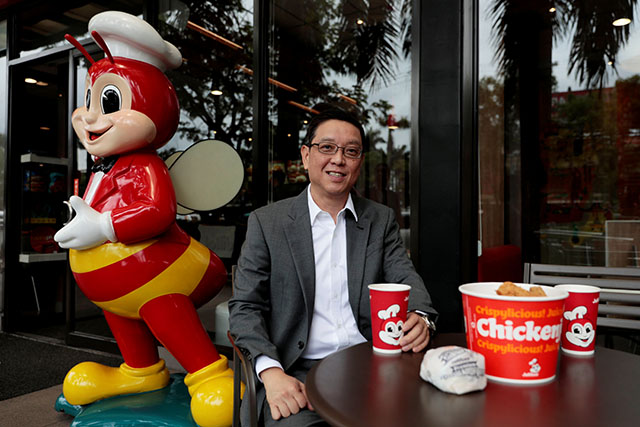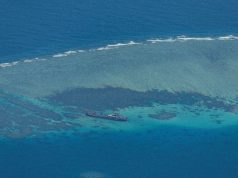
MANILA — Jollibee Foods Corp, the country’s fast-food specialist known for fried ‘Chickenjoy’ and chopped hotdogs in sweet spaghetti sauce, is doubling down on expansion plans in the United States and China that are likely to include more M&A.
Helped by the purchase of California-based Coffee Bean & Tea Leaf in July and having taken full control of Denver-based Smashburger in 2018, it wants to earn 30% of its revenue in the United States in a decade’s time, executives told Reuters.
It is also aiming to lift revenue in China to 30% of overall sales, while the Philippines would fall to 30%.
That would represent a major rejig of revenue streams for Jollibee, which ranks No. 4 among Asia’s listed quick service restaurant firms, and would build upon plans to cut its reliance on its domestic market to 50% of sales in the “medium term.”
Prior to its acquisition of Coffee Bean, the Philippines accounted for 73% of sales while the United States represented 15% and China 12%.
“We want to spread our portfolio and risk,” Jollibee CEO Ernesto Tanmantiong said in an interview. “There’s a huge opportunity out there.”
Jollibee, which is valued at $4.8 billion and has 16 brands or franchises to its name, aims to have six brands each in the United States and China, just as it does in the Philippines.
In the U.S. market, it currently has five including its namesake Jollibee restaurant chain and a minority investment in Tortas Frontera, run by Michelin-starred chef Rick Bayless and which offers Mexican-inspired sandwiches at just three outlets in Chicago’s O’Hare airport.
It has three brands in China — the Dunkin Donuts franchise, as well as the Yonghe King noodle and Hong Zhuang Yuan congee restaurant chains.
Trusting one’s gut
Jollibee likes to acquire quite small, loss-making firms at low prices and turn them around.
It receives business proposals frequently but acquisitions are more often stumbled upon during one of Chairman’s Tony Tan Caktiong long food tasting trips than sought out through bankers.

“Most of the acquisitions resulted from Tan Caktiong eating in a restaurant, liking the food and asking ‘who runs the place?'” said Erwin Elechicon, former chief of Jollibee’s international operations.
That was the case with Tortas Frontera. Tan, also a founder of the company and brother of CEO Tanmantiong, had eaten one of its sandwiches at the airport.
While noting they tend to buy small, Jollibee executives say they are open to any type of acquisition if the food is good.
But they acknowledge their immediate focus is on turning around Smashburger and Coffee Bean — both loss-making and bigger than Jollibee’s usual acquisitions with $210 million spent on Smashburger and Coffee Bean costing $350 million including debt.
Investor concerns that Jollibee is overextended were exacerbated by first-half profit sliding by a third to 2.66 billion pesos ($51 million) due to losses at Smashburger and deliveries problems with its Red Ribbon Bakeshop.
Its stock has lost 18% since late July when it announced its purchase of Coffee Bean.
“It would be better for them not to do another acquisition at least of this scale until Smashburger and CBTL become profitable,” said Renzo Louie Candano, analyst at DBP-Daiwa Capital Markets in Manila.
Jollibee believes, however, that it has not overreached. Nor is it concerned that any of its targeted markets are saturated or that it might not be able to compete with the likes of Starbucks.
“Every restaurant in the Philippines has fried chicken, in Vietnam there are maybe 10 coffee shops on every block. In the midst of all of this competition, there’s always a standout one or two,” said Chief Financial Officer Ysmael Baysa.
“How are you going to do it? Our formula is very simple. Offer the best-tasting food at the right price and you’re going to make it.”
He noted that Coffee Bean had a strong presence in Southeast Asia and the Middle East, regions where coffee culture still has a lot of room to grow and that its Highlands Coffee stores in Vietnam logged revenue growth of around 32% last year.
It has also taken on big chains before.
Not long after Jollibee, originally an ice cream parlor, started selling burgers in 1978, friends advised Tan Caktiong and his brothers to quit, warning the imminent arrival of U.S. giant McDonald’s in the Philippines would decimate Jollibee’s six branches.
Undeterred, the firm took on McDonald’s by surrounding each big branch with smaller Jollibee outlets and measuring the U.S firm’s sales by counting trash outside its branches. Since 1984, Jollibee has outsold McDonald’s domestically.
Outside the Philippines, Jollibee restaurant locations tend to be in areas with large expat Filipino populations. But executives point to its growing popularity with non-Filipinos, particularly in Vietnam, Singapore and Hong Kong.
It also has big plans to expand the Jollibee chain in North America, aiming for 150 U.S. stores and 100 in Canada over five years, up from 37 and 4 respectively. ($1 = 52.0400 Philippine pesos)
— Reporting by Neil Jerome Morales and Martin Petty in Manila; Additional reporting by Anshuman Daga in Singapore; Editing by Edwina Gibbs









